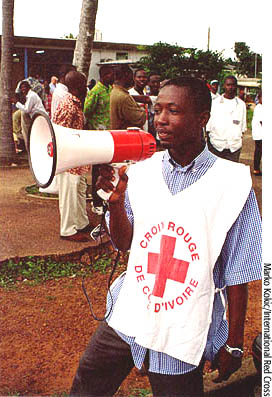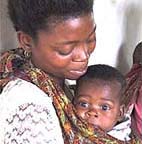| |

October 2001
Return to October
2001 contents page
NEWS
Yellow fever vaccine stocks still low
as fears of new outbreaks grow
THE World Health Organization has appealed
to the international community for funds to stockpile scarce yellow
fever vaccine after a mass immunization campaign in Côte d’Ivoire.
The campaign, successfully completed in Abidjan earlier this month,
immunized an estimated 2.6 million people in under 2 weeks, in an
effort to control the first urban outbreak of yellow fever in Africa
in a decade. Worldwide, there are now at most 1 million remaining
doses of vaccine available for the coming month.
|
"The vaccine supply situation is
very bad," said Michel Zaffran, of the World Health Organization’s
Department of Vaccines and Biologicals. "If there were another
urban outbreak we would need to do a similar campaign and
there would not be enough vaccine right now." As Immunization
Focus went to press, there were unconfirmed reports of
a second outbreak of yellow fever in Conakry, Guinea. Officials
are concerned at the possibility of outbreaks in larger population
centres in West Africa.
Until now, only two manufacturers
– Aventis Pasteur and the Institut Pasteur in Dakar,
Senegal – have supplied the international market. A third
in Brazil, Biomanguinhos, has this month received WHO official
quality approval – or "prequalification" – for its
vaccine. Julie Milstien in the WHO Department of Vaccines
and Biologicals said this would ease the situation somewhat,
but warned that the new supplies would not be available for
another month.
Yellow fever is responsible for
an estimated 200,000 cases of illness and 30,000 deaths each
year. It is caused by a virus which is spread by several species
of mosquito. Most outbreaks are relatively small and confined
to forested areas or villages. The more dangerous urban outbreaks
occur when infected people introduce the virus into a densely
populated area, where it is rapidly spread by Aedes aegypti
mosquitoes. As of 10 October, Côte d’Ivoire's
ministry of health had reported 203 suspected cases of the
disease and 21 deaths in the current outbreak, although actual
numbers are likely to be much higher.
|
 Come and get it:
Come and get it:
a Red Cross volunteer appeals to the public in Côte
d’Ivoire to attend vaccination centres |
Ideally, says WHO, countries should
offer routine immunization against yellow fever, with catch-up campaigns
where necessary. So far, however, only a minority of countries at
risk have invested in routine immunization against the disease.
For the outbreak in Côte d’Ivoire,
WHO, UNICEF, the Red Cross and other donors have spent US $1.1 million
on vaccine and supplies. "Additional funds are urgently needed to
complete financing of the operation," said WHO.
Phyllida Brown
Return to October 2001 contents
page
|


